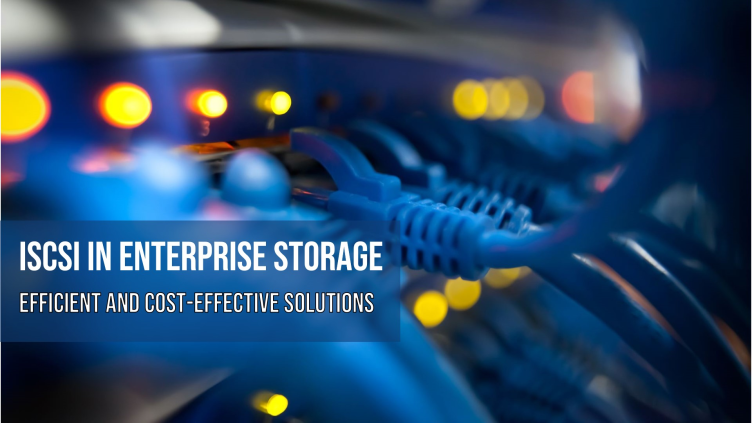Case Study: Implementing iSCSI for Enterprise Storage Solutions
 Abhay Dandge
Abhay Dandge
Objective
This case study explores the potential adoption of iSCSI (Internet Small Computer System Interface) technology as a storage solution for your company. It covers the concept of iSCSI, its implications for the infrastructure, and the prerequisites required for successful implementation.
Scenario
Your organization is considering moving towards a centralized storage solution, and iSCSI has been identified as a possible candidate. The goal is to understand iSCSI technology, analyze its potential benefits, and determine whether it is the right fit for the company's needs.
1. Understanding iSCSI Technology
iSCSI is a protocol that enables the transfer of data over IP networks using block-level storage. This allows remote storage devices to appear as if they were locally attached to the server. It enables the creation of Storage Area Networks (SANs) over existing Ethernet infrastructure, eliminating the need for more complex and expensive Fiber Channel-based SANs.
Key features of iSCSI include:
Block-level access: iSCSI enables storage access at the block level, which is ideal for high-performance applications like databases and virtual machines.
Use of existing infrastructure: iSCSI can run over your current Ethernet network, making it cost-effective compared to Fiber Channel.
Scalability: iSCSI allows easy expansion of storage by simply adding more storage devices or arrays to the network.
2. Implications of Adopting iSCSI
a. Performance Considerations
iSCSI provides high-performance storage by offering block-level access. This is especially beneficial for high I/O workloads such as databases, virtual machines, and transactional systems. However, to get optimal performance, you may need to upgrade your network to 10GbE or higher to avoid bandwidth bottlenecks.
For businesses with performance-sensitive applications, iSCSI can deliver lower latency and faster access compared to file-based systems like NFS (Network File System). Additionally, using iSCSI allows for dedicated storage networks, further reducing latency.
b. Simplified Infrastructure
Since iSCSI leverages IP-based networks, it simplifies storage infrastructure by utilizing existing Ethernet infrastructure. This eliminates the need for specialized hardware like Fiber Channel switches and cables, reducing both capital and operational expenses. However, to avoid congestion and ensure quality of service, some organizations prefer to create dedicated VLANs or separate networks for iSCSI traffic.
c. Flexibility and Scalability
iSCSI offers high flexibility, as it allows storage administrators to allocate storage dynamically to servers based on demand. This results in better resource management and scalability without physical reconfiguration.
Additionally, iSCSI is ideal for virtualized environments where storage needs can change rapidly. It integrates well with virtual machine hosts, enabling storage to be dynamically allocated to VMs.
d. Centralized Management
With iSCSI, storage management becomes centralized, allowing IT teams to manage storage from a single interface. This centralization leads to better oversight, easier backups, and streamlined disaster recovery strategies.
e. Security Concerns
Since iSCSI operates over an IP network, it is vulnerable to typical network security threats. However, iSCSI can be secured using CHAP (Challenge-Handshake Authentication Protocol) for authentication and IPsec to encrypt data in transit, mitigating the risk of data breaches.
3. Prerequisites and Requirements for Implementing iSCSI
a. Network Infrastructure
For optimal performance, an existing Ethernet network should be evaluated for its ability to handle iSCSI traffic. High-performance environments may require a dedicated storage network or VLANs, and upgrading to 10GbE or higher is recommended for bandwidth-intensive applications.
b. iSCSI Initiators and Targets
iSCSI initiator: Installed on the server that requests access to the storage. Many modern operating systems, such as Linux, Windows, and VMware, include built-in iSCSI initiators.
iSCSI target: The storage device or server that shares its storage over the network. It could be an enterprise-grade storage array, a SAN device, or a simple server exporting block storage.
c. Storage Allocation and LUN Management
Before deploying iSCSI, IT teams must decide how to allocate storage by creating LUNs (Logical Unit Numbers). These are segments of the storage that are assigned to specific initiators (servers) for exclusive use. Proper LUN management is critical for optimizing performance and ensuring efficient storage utilization.
d. Security Configurations
CHAP authentication: Ensures that only authorized servers can connect to the iSCSI target.
Network isolation: Implement network segmentation or use VPNs for isolating iSCSI traffic from the general network to minimize attack vectors.
e. Storage Monitoring and Backup
To ensure high availability and disaster recovery, integrating iSCSI with existing backup systems is necessary. IT teams should implement monitoring tools to track performance, storage usage, and potential bottlenecks.
4. Benefits of iSCSI for Your Organization
a. Cost-Effective Storage
iSCSI is a cost-effective solution because it eliminates the need for expensive Fiber Channel infrastructure. It allows your company to leverage existing Ethernet infrastructure for storage, reducing both capital and operational costs.
b. High Availability and Disaster Recovery
iSCSI's integration with enterprise-grade storage arrays enables robust high-availability features such as RAID, snapshots, and replication. This ensures that your organization’s critical data remains safe and accessible in case of hardware failure or network issues.
c. Scalability for Growth
As your company grows, iSCSI allows easy scalability. Adding new storage to the SAN is a seamless process, requiring no changes to existing infrastructure or downtime. This makes it a future-proof solution, accommodating your evolving storage needs.
d. Enhanced Storage Management
iSCSI centralizes storage management, making it easier to monitor and control how storage is allocated and used across your organization. It simplifies processes like provisioning new storage and expanding capacity as needed.
Conclusion
iSCSI is a powerful and flexible storage solution that fits well in environments requiring block-level storage for high-performance applications such as databases and virtualization. It provides cost-effective scalability and simplifies infrastructure by using existing Ethernet networks. However, ensuring network bandwidth, security, and proper LUN management are crucial for its successful deployment.
Given your company's growth and potential need for scalable, high-performance storage, iSCSI presents a strong case as a future storage solution. However, if file sharing across multiple systems is a priority or simplicity is desired, exploring NFS may also be worth considering.
Next Steps
Conduct a detailed network assessment to evaluate bandwidth and potential upgrade requirements.
Set up a proof of concept (PoC) for iSCSI to test performance in your environment.
Ensure that your IT team is trained on iSCSI management and LUN configurations.
Explore potential hybrid solutions, combining iSCSI for block storage and NFS for file sharing if applicable.
Subscribe to my newsletter
Read articles from Abhay Dandge directly inside your inbox. Subscribe to the newsletter, and don't miss out.
Written by

Abhay Dandge
Abhay Dandge
Hello, I'm Abhay, a DevOps Engineer passionate about optimizing operations through automation, continuous integration, and deployment. Over the past year, I've sharpened my skills in the fast-paced world of DevOps and Cloud Computing. My journey has been defined by hands-on experience and a commitment to exploring the latest technologies. ╭━━━╮╱╱╱╱╱╭━━━╮ ╰╮╭╮┃╱╱╱╱╱┃╭━╮┃ ╱┃┃┃┣━━┳╮╭┫┃╱┃┣━━┳━━╮ ╱┃┃┃┃┃━┫╰╯┃┃╱┃┃╭╮┃━━┫ ╭╯╰╯┃┃━╋╮╭┫╰━╯┃╰╯┣━━┃ ╰━━━┻━━╯╰╯╰━━━┫╭━┻━━╯ ╱╱╱╱╱╱╱╱╱╱╱╱╱╱┃┃ ╱╱╱╱╱╱╱╱╱╱╱╱╱╱╰╯⠀⠀⠀⠀⠀⠀⠀⠀⠀⠀⠀⠀⠀⠀⠀⠀⠀⠀⠀⠀⠀⠀⠀ In my tech toolkit, I’ve got the skills to make things run smoother: containerization, cloud platforms, and flawless CI/CD pipelines. My goal? To supercharge software delivery for organizations, making it faster and more efficient, all while keeping things top-notch and rock-solid. Let’s keep it cool and reliable! 🅃🄴🄲🄷 🅂🅃🄰🄲🄺 🔲 Cᴏɴᴛᴀɪɴᴇʀɪᴢᴀᴛɪᴏɴ -: Dᴏᴄᴋᴇʀ | Pᴏᴅᴍᴀɴ | Bᴜɪʟᴅᴀʜ | CᴏɴᴛᴀɪɴᴇʀD 🔲 Cᴏɴᴛᴀɪɴᴇʀ Oʀᴄʜᴇsᴛʀᴀᴛɪᴏɴ -: Kᴜʙᴇʀɴᴇᴛᴇs | Dᴏᴄᴋᴇʀ Sᴡᴀʀᴍ 🔲 Cʟᴏᴜᴅ Pʟᴀᴛғᴏʀᴍs -: AWS 🔲 Aᴜᴛᴏᴍᴀᴛɪᴏɴ ᴀɴᴅ Sᴄʀɪᴘᴛɪɴɢ-: Bᴀsʜ, Pʏᴛʜᴏɴ * Linux Administration (RHCSA) 🔴 * DevOps methodologies. * CLA (Certified Linux Admin) * CCA (Certified Container Admin) -̶-̶-̶-̶-̶-̶-̶-̶-̶-̶-̶-̶-̶-̶-̶-̶-̶-̶-̶-̶-̶-̶-̶-̶-̶-̶-̶-̶-̶-̶-̶-̶-̶-̶-̶-̶-̶-̶-̶-̶-̶-̶-̶-̶-̶-̶-̶-̶-̶-̶-̶-̶-̶-̶-̶-̶-̶-̶-̶-̶-̶-̶-̶-̶-̶-̶-̶-̶-̶-̶-̶-̶-̶-̶-̶-̶-̶-̶-̶-̶-̶-̶-̶-̶-̶-̶-̶-̶-̶-̶-̶-̶-̶-̶-̶-̶-̶-̶-̶-̶-̶-̶- How can I help you? I can help you with the optimization and scalability of your infrastructure with my expertise in Linux, Containers, AWS, and orchestration. From streamlining deployments with Docker and Kubernetes to maximizing cloud efficiency, I'll ensure your systems are robust and scalable. Let's tackle your challenges and take your projects to the next level. Let's connect and discuss how we can collaborate! :) -̶-̶-̶-̶-̶-̶-̶-̶-̶-̶-̶-̶-̶-̶-̶-̶-̶-̶-̶-̶-̶-̶-̶-̶-̶-̶-̶-̶-̶-̶-̶-̶-̶-̶-̶-̶-̶-̶-̶-̶-̶-̶-̶-̶-̶-̶-̶-̶-̶-̶-̶-̶-̶-̶-̶-̶-̶-̶-̶-̶-̶-̶-̶-̶-̶-̶-̶-̶-̶-̶-̶-̶-̶-̶-̶-̶-̶-̶-̶-̶-̶-̶-̶-̶-̶-̶-̶-̶-̶-̶-̶-̶-̶-̶-̶-̶-̶-̶-̶-̶-̶-̶-̶-̶-̶-̶-̶-̶-̶-̶-̶-̶-̶-̶- ………………………………………………………………… #devops #devsecops #sre